Electric Power Steering (EPS) Sensor Market Research, 2030
The global electric power steering (eps) sensor industry was valued at $14.64 billion in 2021, and is projected to reach $26.58 billion by 2030, growing at a CAGR of 7% from 2022 to 2030.
Electric power steering sensors commands and assists the steering process with support of an intelligence electric motor. The control unit inside the EPS calculates the ideal steering support based upon the steering signal from torque sensors and delivers the information to the electric motor to offer the required assistance. Hydraulic power steering which was widely used before EPS, had many components such as pump, hoses, fluid, drive belt, and pulley to operate. These components needed space and also increased the weight of the vehicle; however, the EPS does not have these thus making the electric steering systems lighter & smaller than hydraulic systems. Due to these factors, EPS is widely used in new generation vehicles and it will contribute to the Electric Power Steering (EPS) Sensor Market Size.
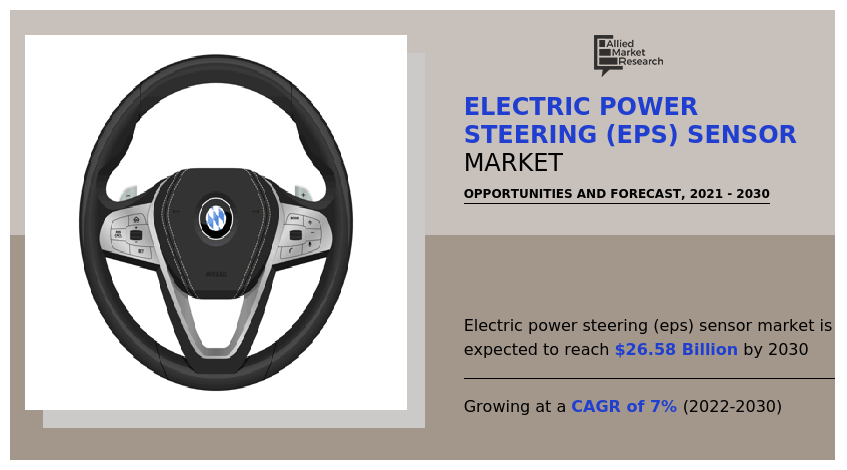
Increasing amount of vehicle manufacturing and rising number of accidents have created a need to increase adoption of EPS sensors in vehicles thus boosting Electric Power Steering (EPS) Sensor Market Share. With rising demand in safety of vehicles, EPS suits the best as they assist to enhance the driving experience. According to the vehicle sales data by International Organization of Motor Vehicle Manufacturers, an international trade association whose members are 39 national automotive industry trade associations, there has been a rise in vehicle sales by 4.96% in 2021, as compared to 78 million in 2020. Thus, an increase in the sales of vehicles will eventually add to the Electric Power Steering (EPS) Sensor Market Size.
However, with adoption of electric power steering driver may lack the driving experience as the steering feels extremely light to handle. Hydraulic steering systems require more muscle to move the vehicle and offers the driver more stability on high speeds. Thus, driving enthusiast feel the lack of steering feel and driving experience on EPS. These factors are anticipated to propel the electric power steering (EPS) sensor market growth.
Rising penetration of electric power steering systems in the passenger and commercial vehicles along with increasing demand for electric and automatic vehicles is anticipated to drive revenue growth of the electric power steering (eps) sensor market in the predicted years. The EPS sensors are more reliable than the hydraulic steering systems in terms of safety, fuel efficacy, and adaptability to adjustable driving modes. Moreover, in March 2022, Yamaha Motor Co., ltd, a Japanese motorcycle manufacturer, announced the use of EPS sensors in Yamaha YZ450FM and YZ250F racing motorcycles and tested them to develop and use in production motorcycles. The use of EPS will give the rider stability and improved agility and reduce fatigue. Thus, these factors will increase the Electric Power Steering (EPS) Sensor Market Share in the future.
Key Takeaways
The global market study covers 20 countries. The research includes a segment analysis of each country in terms of value for the projected period.
More than 1,500 product literatures, industry releases, annual reports, and other such documents of major electric power steering (eps) sensor market industry participants along with authentic industry journals, trade associations' releases, and government websites have been reviewed for generating high-value industry insights.
The study integrated high-quality data, professional opinions and analysis, and critical independent perspectives. The research approach is intended to provide a balanced view of global markets and to assist stakeholders in making educated decisions to achieve their most ambitious growth objectives.
Key Market Dynamics
The market dynamics for electric power steering (EPS) sensors are influenced by several key drivers. Firstly, the growing demand for fuel-efficient vehicles is pushing automakers to adopt EPS technology, which enhances energy efficiency compared to traditional hydraulic systems. Secondly, the increasing focus on vehicle safety and advanced driver assistance systems (ADAS) is driving the need for precise and responsive steering capabilities, making EPS sensors crucial for modern vehicles. Lastly, the trend toward electrification in the automotive sector is promoting the integration of EPS systems. However, a significant restraint is the high cost of EPS systems compared to traditional steering mechanisms, which can deter some manufacturers from making the switch. Despite this challenge, there is a notable opportunity for growth as the automotive industry increasingly embraces electric and hybrid vehicles, creating demand for EPS sensors that enhance steering performance and vehicle dynamics.
Segment Overview:
The global Electric Power Steering (EPS) sensor market is segmented on basis of vehicle-type, sensor type, distribution channel, and region. By vehicle type, the market is sub-segmented into passenger vehicle and commercial vehicle. By sensor type, the market is sub-segmented into speed sensor, steering torque sensor, and steering wheel position sensor. By distribution channel, it is sub-segmented into Original Equipment Manufacturer (OEM) and aftermarket. By region, the market is analyzed across North America, Europe, Asia-Pacific, and LAMEA.
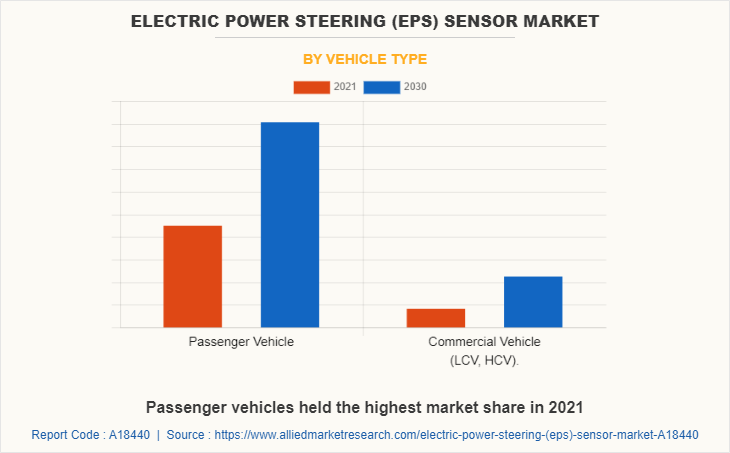
By vehicle type, the passenger vehicle sub-segment is predicted to be dominating and fastest growing sub-segment in the global electric power steering (eps) sensor market during the forecast period. 30% of passenger cars globally are equipped with EPS technology, and this technology is expected to be used in budget passenger cars during the forecast period. Owing to these developments, passenger vehicle sub-segment dominated the vehicle type segment and likely to grow substantially in the coming years. In addition to these, rising number of passenger vehicles as the primary medium of mobility across the world is expected to fuel revenue growth of the market in the forecast period.
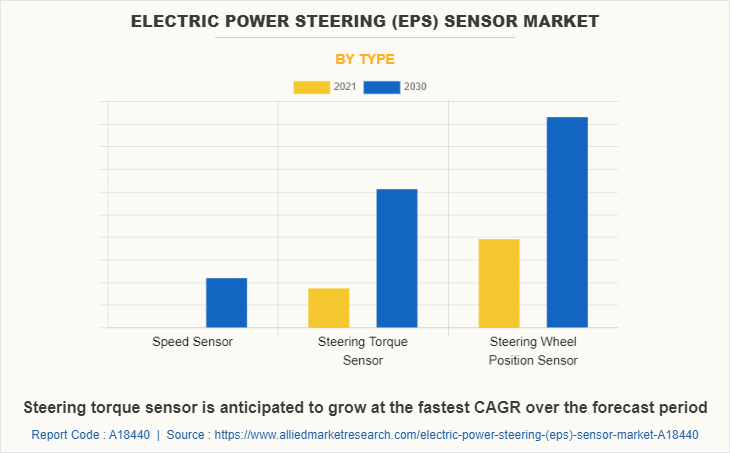
By sensor type, the steering torque sensor is predicted to show the fastest growth and steering wheel position sensor sub-segment is expected to gain a dominant market share in the forecasted period. Increasing utility of contactless torque sensors by OEMs to enhance fuel efficiency is expected to boost steering torque sensor sub-segment growth in the electric power steering (eps) sensor market. Increasing developments in non-contacting position sensors based on magnetic sensing principles is anticipated to drive revenue growth of the steering wheel position sub-segment in the forecast period.
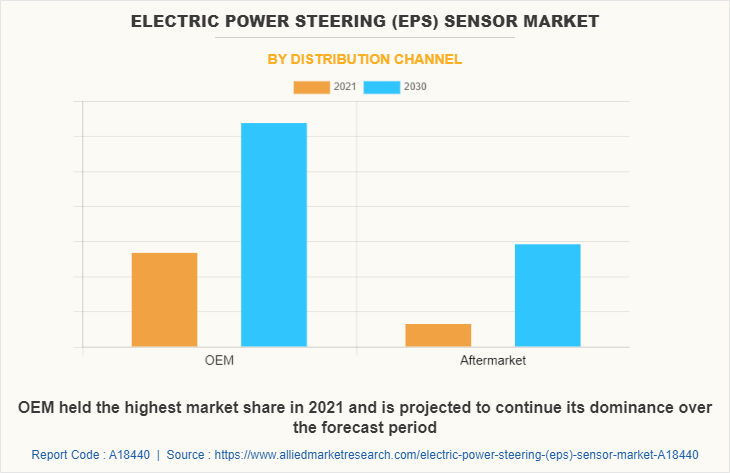
By distribution channel, the aftermarket sub-segment is predicted to show the fastest growth and OEM sub-segment is expected to garner a dominant market share. Rising demand for upgrades to existing automotive electronics systems, which include EPS sensors, is expected to boost expansion of the aftermarket sub-segment. Whereas, software advancements in the EPS-Motor Control Unit are becoming more prevalent, allowing the unit to seamlessly integrate into the car after it is installed at the manufacturing plants. Vehicle handling and safety are being enhanced because of advancements in motor control systems. These factors are expected to boost the OEM sub-segment revenue growth.
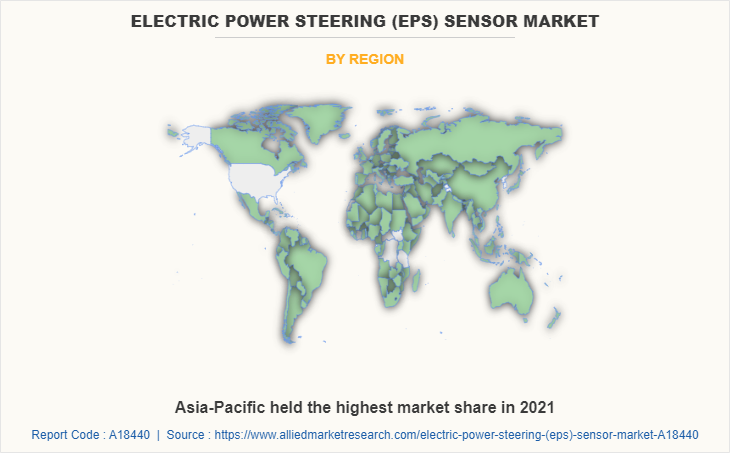
By region, the Asia-Pacific region is predicted to show the fastest growth and dominate the market in the predicted years. The electric power steering (eps) sensor market is anticipated to grow over the forecast period due to China's position as the world's largest auto manufacturer, Japan's and South Korea's position as the largest auto exporters, large-scale manufacturing, and significant investments in new vehicle technologies made in the region.
Regional/Country Market Outlook
North America: The North American market for Electric Power Steering (EPS) sensors is driven by the strong presence of leading automotive manufacturers and a growing demand for advanced vehicle safety features. The shift towards electric and hybrid vehicles is further propelling the adoption of EPS technology in the region.
Europe: Europe is at the forefront of EPS sensor adoption, primarily due to stringent regulations on vehicle emissions and safety standards. The increasing emphasis on electric mobility and innovation in automotive technology is fostering significant growth in the electric power steering (eps) sensor market across European countries.
Asia-Pacific: The Asia-Pacific region is witnessing rapid growth in the electric power steering (eps) sensor market, fueled by booming automotive production, particularly in countries like China, Japan, and India. The rising consumer preference for fuel-efficient and technologically advanced vehicles is accelerating the demand for EPS systems in this region.
LAMEA: The LAMEA market for EPS sensors is gradually expanding as automotive manufacturers increasingly adopt advanced steering technologies. Growth is driven by improving infrastructure, rising disposable incomes, and a growing focus on vehicle safety, particularly in urban areas of Latin America and the Middle East.
Competitive Analysis
The major key players in the global Electric Power Steering (EPS) sensor market are Robert Bosch GmbH, HELLA GmbH & Co. KgaA, DENSO Corporation, Valeo, Continental AG, Infineon Technologies AG, Sensata Technologies, TT Electronics, NXP Semiconductors, and Asahi Kasei Corporation.
Report Coverage & Deliverables
This report delivers in-depth insights into the electric power steering (EPS) sensor market, by type, vehicle type, distribution channel, and key strategies employed by major players. It offers detailed market forecasts and emerging trends.
Type Insights
Electric Power Steering (EPS) sensors include speed sensors, steering torque sensors, and steering wheel position sensors. Speed sensors monitor vehicle speed to enhance steering response, while steering torque sensors measure the force applied to the steering wheel, improving handling. Steering wheel position sensors determine the wheel's angle, enabling features like lane-keeping assistance.
Vehicle Type Insights
The electric power steering (eps) sensor market is driven by passenger vehicles, which demand enhanced safety features and fuel efficiency. Commercial vehicles, including light and heavy commercial vehicles, are also adopting EPS technology to improve manoeuvrability and driver comfort, particularly in urban environments.
Distribution Insights
Original Equipment Manufacturers (OEMs) dominate the electric power steering (eps) sensor market by integrating these components into new vehicles, aligning with advanced steering technology trends. The aftermarket segment is growing as vehicle owners seek to upgrade or replace EPS components, driven by increasing maintenance and repair activities.
Key Strategies and Developments
In October 2020, Nexteer Automotive, introduced its High-Output Electric Power Steering (EPS) system. This system provides advanced safety and comfort features, as well as improved fuel efficiency for heavy-duty (HD) trucks and light commercial vehicles (LCVs). These innovative products present significant growth opportunities for the global electric power steering (eps) sensor market.
In December 2021, ZF Friedrichshafen AG obtained a majority ownership stake in its joint venture in India with Rane Group. This partnership manufactures automotive components for both the domestic electric power steering (eps) sensor market in India and for export.
Key Benefits For Stakeholders
- This report provides a quantitative analysis of the market segments, current trends, estimations, and dynamics of the electric power steering (eps) sensor market analysis from 2021 to 2030 to identify the prevailing electric power steering (eps) sensor market opportunities.
- The electric power steering (eps) sensor market research is offered along with information related to key drivers, restraints, and opportunities.
- Porter's five forces analysis highlights the potency of buyers and suppliers to enable stakeholders make profit-oriented business decisions and strengthen their supplier-buyer network.
- In-depth analysis of the electric power steering (eps) sensor market forecast assists to determine the prevailing market opportunities.
- Major countries in each region are mapped according to their revenue contribution to the global electric power steering (eps) sensor market.
- Market player positioning facilitates benchmarking and provides a clear understanding of the present position of the market players.
- The report includes the analysis of the regional as well as global electric power steering (eps) sensor market trends, key players, market segments, application areas, and electric power steering (EPS) sensor market outlook.
Electric Power Steering (EPS) Sensor Market Report Highlights
| Aspects | Details |
| By Type |
|
| By Vehicle Type |
|
| By Distribution Channel |
|
| By Region |
|
| Key Market Players | DENSO CORPORATION, NXP Semiconductors N.V., robert bosch gmbh, HELLA GmbH & Co. KgaA, sensata technologies, inc., continental ag, Valeo SA, Infineon Technology, TT Electronics plc |
Analyst Review
Increasing number of road accidents have created the need to manufacture safer vehicles. Electric Power Steering (EPS) offers the vehicle with enhanced stability and controlling. In addition, EPS’s lighter and smaller components help reduce weight of the vehicle and in turn provide more fuel efficiency. There has also been an increase in number of vehicles’ sales all over the globe and adoption of EPS in commercial and passenger vehicles is projected to fuel revenue growth of the market as well. Even key players in the market such as YAMAHA are testing the use of EPS in two wheelers. The entry of EPS in two wheelers will eventually drive the EPS sensor market growth in the forecasted years. However, major vehicle recalls due to issues in EPS are expected to create a huge loss to the market. The Asia-Pacific region is predicted to show the fastest growth and dominate the market in the predicted years. With China being the world's largest automotive manufacturer, and Japan and South Korea as the world's largest auto exporters, large-scale manufacturing and significant expenditures in new vehicle technologies are carried out in the region, owing to which EPS sensor market is expected to flourish over the forecast period.
Among the analysed regions, Asia-Pacific is expected to account for the highest revenue in the market by the end of 2031, followed by North America, Europe, and LAMEA. Rapid industrialization and increase demand for passenger cars are the key factors responsible for leading position of Asia-Pacific and North America in the global electric power steering market.
Increasing number of road accidents, need for safe and fuel-efficient vehicles along with enhanced driving performance will contribute to the global Electric Power Steering (EPS) sensor market in the forecasted years.
Passenger vehicle sub-segment of the vehicle type segment acquired the maximum share of the global Electric Power Steering (EPS) sensor market in 2021.
Adoption of EPS in two wheelers as well as passenger vehicles will influence the market in the next years.
Asia-Pacific will provide more business opportunities for the global electric power steering sensor market in future.
The major key players in the global EPS sensor market are Robert Bosch GmbH, HELLA GmbH & Co. KgaA, DENSO Corporation, Valeo, Continental AG, Infineon Technologies AG, Sensata Technologies, TT Electronics, NXP Semiconductors, and Asahi Kasei Corporation.
The major growth strategies adopted by electric power steering sensor market players include product launches and mergers & acquisitions.
Who are the potential customers of global electric power steering sensor market?
The report provides an extensive qualitative and quantitative analysis of the current trends and future estimations of the global Electric Power Steering (EPS) sensor market from 2022 to 2030 to determine the prevailing opportunities.
Loading Table Of Content...



